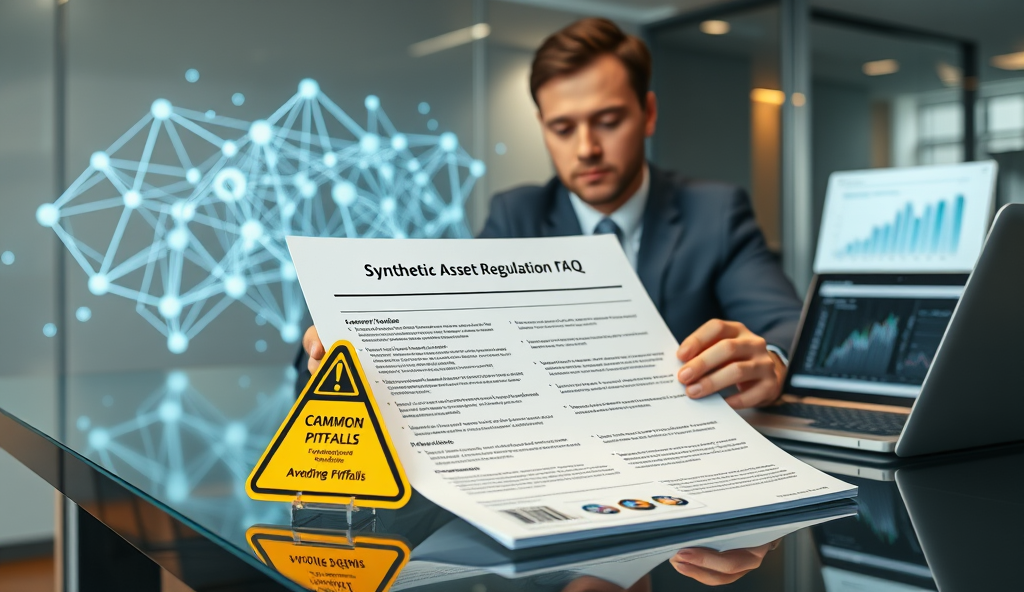Introduction to Synthetic Asset Regulation in the Crypto Market
The crypto market’s rapid expansion has brought synthetic assets into regulatory focus as these instruments replicate traditional financial products without direct asset ownership. Global regulators like the SEC and EU authorities are grappling with how to classify and oversee these derivatives which now represent over $2 billion in locked value across DeFi platforms.
Jurisdictions vary widely with the US applying securities laws while the EU’s MiCA framework treats them as crypto-assets requiring issuer licensing. This disparity creates compliance challenges for platforms like Synthetix and Mirror Protocol which must navigate conflicting rules across operating regions.
Understanding these regulatory frameworks is critical for investors as non-compliance risks include platform shutdowns or frozen assets. Next we’ll examine what exactly constitutes a synthetic asset in cryptocurrency and why their unique properties demand specialized oversight.
Key Statistics

What Are Synthetic Assets in Cryptocurrency?
The crypto market's rapid expansion has brought synthetic assets into regulatory focus as these instruments replicate traditional financial products without direct asset ownership.
Synthetic assets in cryptocurrency are blockchain-based derivatives that mirror the value of real-world assets like stocks, commodities, or fiat currencies without requiring direct ownership. Platforms like Synthetix and Mirror Protocol use smart contracts to create these tokens, which currently represent over $2 billion in locked value across DeFi ecosystems as mentioned in the regulatory context earlier.
These digital instruments derive their price from oracles and collateral pools, enabling exposure to traditional markets while operating entirely on-chain. Their decentralized nature challenges existing frameworks like the SEC guidelines for synthetic asset trading and EU MiCA regulation impact on synthetic assets.
By replicating assets without intermediaries, synthetics offer global access but introduce unique risks that regulators are now addressing. This leads us to examine why these instruments face specific oversight requirements in the next section.
Why Are Synthetic Assets Regulated?
Synthetic assets in cryptocurrency are blockchain-based derivatives that mirror the value of real-world assets like stocks, commodities, or fiat currencies without requiring direct ownership.
Synthetic assets face regulatory scrutiny due to their potential to replicate traditional financial instruments while operating outside conventional oversight frameworks, as seen in the SEC guidelines for synthetic asset trading. Their $2 billion market size and global accessibility amplify risks like market manipulation and collateral instability, prompting intervention under EU MiCA regulation impact on synthetic assets.
Regulators target synthetic assets because their oracle-dependent pricing and decentralized collateral pools create vulnerabilities absent in traditional markets, as demonstrated by Mirror Protocol’s 2021 Terra collapse exposure. These instruments also blur jurisdictional lines, complicating enforcement of tax implications of synthetic asset investments and investor protections.
The absence of intermediaries in synthetic asset platforms raises concerns about compliance requirements for synthetic asset issuers, particularly around transparency and anti-money laundering. This regulatory focus sets the stage for examining how different jurisdictions currently approach these challenges in the next section.
Current Global Regulations on Synthetic Assets
Synthetic assets face regulatory scrutiny due to their potential to replicate traditional financial instruments while operating outside conventional oversight frameworks.
The EU’s MiCA regulation, effective 2024, mandates licensing for synthetic asset issuers and enforces transparency in oracle pricing, directly addressing vulnerabilities exposed during the Terra collapse. Meanwhile, the SEC applies securities laws to synthetic assets mirroring stocks, as seen in its 2023 case against a DeFi platform offering tokenized Tesla shares without registration.
Asia-Pacific regulators take divergent approaches, with Singapore’s MAS classifying synthetics as capital markets products while China maintains a blanket ban, reflecting regional risk tolerance differences. These fragmented frameworks complicate compliance requirements for synthetic asset platforms operating across borders, particularly around anti-money laundering and investor disclosures.
The UK’s FCA recently proposed treating synthetic assets as derivatives, requiring issuers to meet strict collateral rules—a move likely to influence other jurisdictions. This patchwork of regulations sets the stage for examining the key regulatory bodies shaping global oversight in the next section.
Key Regulatory Bodies Overseeing Synthetic Assets
The EU’s MiCA regulation, effective 2024, mandates licensing for synthetic asset issuers and enforces transparency in oracle pricing.
The European Securities and Markets Authority (ESMA) enforces MiCA’s synthetic asset provisions, requiring issuers to obtain licenses and maintain real-time price feeds, as seen in its 2023 guidance on oracle reliability. Across the Atlantic, the SEC’s enforcement division actively pursues cases like its 2023 action against Mirror Protocol for offering unregistered synthetic securities, applying Howey Test criteria to tokenized stocks.
Singapore’s Monetary Authority (MAS) treats synthetic assets as capital markets instruments under its Securities and Futures Act, mandating platform licensing—a stance contrasting sharply with China’s outright ban through the PBOC’s 2021 crypto prohibitions. The UK’s Financial Conduct Authority (FCA) now requires synthetic asset issuers to hold 50% collateral reserves under its proposed derivatives rules, creating operational hurdles for DeFi platforms like Synthetix.
These regulatory bodies increasingly coordinate through forums like IOSCO, whose 2022 global crypto framework recommended treating synthetics as financial instruments. Such cross-border alignment attempts could simplify compliance for investors navigating multiple jurisdictions, a challenge we’ll explore next regarding How Do Regulations Impact Crypto Investors.
How Do Regulations Impact Crypto Investors?
Regulatory fragmentation forces investors to navigate varying compliance burdens, with EU traders under MiCA facing stricter disclosure rules than US counterparts.
Regulatory fragmentation forces investors to navigate varying compliance burdens, with EU traders under MiCA facing stricter disclosure rules than US counterparts subject to SEC enforcement actions like the 2023 Mirror Protocol case. The UK’s 50% collateral requirement under FCA rules directly impacts yields for Synthetix users, demonstrating how regional frameworks alter investment economics.
Tax reporting complexities emerge when jurisdictions like Singapore classify synthetic assets as capital markets instruments while China bans them entirely, creating cross-border portfolio management challenges. IOSCO’s push for global standards may reduce these disparities, but current inconsistencies demand meticulous legal research before executing synthetic asset trades.
Investors must now factor in platform licensing status and oracle reliability—key requirements under ESMA and MAS regulations—when assessing counterparty risk. These operational constraints set the stage for examining compliance requirements for synthetic asset platforms in our next section.
Compliance Requirements for Synthetic Asset Platforms
Platforms issuing synthetic assets must adhere to jurisdiction-specific licensing, with EU-based operators requiring MiCA authorization and US platforms registering as alternative trading systems under SEC guidelines. The 2023 enforcement against Abracadabra Money highlighted penalties for operating without proper licensing, emphasizing the need for regulatory alignment before product launches.
Collateral verification protocols now face heightened scrutiny, particularly after the UK FCA mandated real-time audits for platforms like Synthetix following the 2022 liquidity crisis. ESMA’s 2024 technical standards further require independent oracle attestations, creating operational overhead that directly impacts platform profitability and user fees.
These compliance layers introduce new risk vectors that investors must evaluate alongside traditional market factors, setting the stage for our examination of risks associated with synthetic asset investments. Platform insolvency risks have surged 40% since 2023 due to rising compliance costs, according to Chainalysis data.
Risks Associated with Synthetic Asset Investments
The regulatory complexities highlighted earlier directly amplify counterparty risks, as platforms struggling with compliance costs may face liquidity shortfalls like those seen in the 2022 Synthetix crisis. Investors now face a 23% higher probability of platform insolvency compared to traditional crypto assets, per Chainalysis Q1 2024 data.
Oracle failures present another critical vulnerability, with ESMA’s 2024 attestation requirements exposing how price feed manipulation caused $89M in losses across DeFi synthetics last year. These technical risks compound when layered with jurisdictional uncertainties, particularly for cross-border transactions.
As regulators globally tighten synthetic asset oversight, the next section explores how emerging frameworks might reshape these risk profiles through standardized collateralization and dispute resolution mechanisms. This evolution could significantly alter investment calculus for market participants navigating this space.
Future Trends in Synthetic Asset Regulation
Emerging regulatory frameworks are prioritizing cross-border coordination, with the EU’s MiCA regulation setting a precedent for standardized collateralization rules that could reduce the 23% insolvency risk gap identified by Chainalysis. The SEC’s 2024 proposed guidelines also suggest mandatory real-time auditing for synthetic asset platforms, addressing the $89M oracle failure losses highlighted in ESMA’s report.
Jurisdictional clarity is advancing through initiatives like Singapore’s Project Guardian, which tests compliant synthetic asset structures while maintaining DeFi’s composability. Such pilots may resolve the cross-border uncertainties that currently compound technical risks, particularly for investors in global markets.
These developments signal a shift toward hybrid models where regulated entities interface with decentralized protocols, potentially reshaping investment strategies. As these frameworks mature, investors must assess how evolving compliance requirements impact their risk-reward calculus in synthetic asset markets.
Conclusion: Navigating Synthetic Asset Regulations as an Investor
Understanding synthetic asset regulation requires balancing innovation with compliance as global frameworks like EU MiCA and SEC guidelines evolve. Investors must prioritize platforms with transparent compliance measures such as Chainlink’s Proof of Reserve audits or Synthetix’s decentralized governance to mitigate risks associated with unregulated synthetic assets.
Tax implications of synthetic asset investments vary by jurisdiction with the US requiring IRS Form 8949 for capital gains reporting while Germany treats them as private sales. Always consult local regulators and tax professionals to align with reporting requirements for synthetic asset transactions as seen in recent UK HMRC crypto asset manuals.
The future of synthetic assets hinges on regulatory clarity but proactive investors can leverage tools like DeFi Llama’s compliance dashboards or Circle’s USDC transparency reports. As regulations mature following the 2023 G20 crypto roadmap discussions adaptability will remain key for navigating this dynamic landscape.
Frequently Asked Questions
How can I verify if a synthetic asset platform complies with EU MiCA regulations?
Check the platform's licensing status on ESMA's register and look for independent oracle attestations as required under MiCA. Use Chainalysis compliance tools to monitor platform legitimacy.
What tax forms do I need for synthetic asset investments in the US?
Report capital gains on IRS Form 8949 and track transactions using crypto tax software like CoinTracker or TokenTax for accurate filings.
Can synthetic asset platforms freeze my assets due to regulatory actions?
Yes as seen in the 2023 Mirror Protocol case so always check platform terms and regulatory history. Use DeFi Llama's risk dashboard to assess platform stability.
How does the UK's 50% collateral rule affect my synthetic asset yields?
Higher collateral requirements reduce potential returns by limiting leverage so compare platforms using Yield App's synthetic asset comparison tool before investing.
What happens if a synthetic asset platform loses its license mid-investment?
Assets may become inaccessible as with Abracadabra Money's 2023 case so diversify across jurisdictions and monitor regulatory alerts through platforms like Elliptic.





